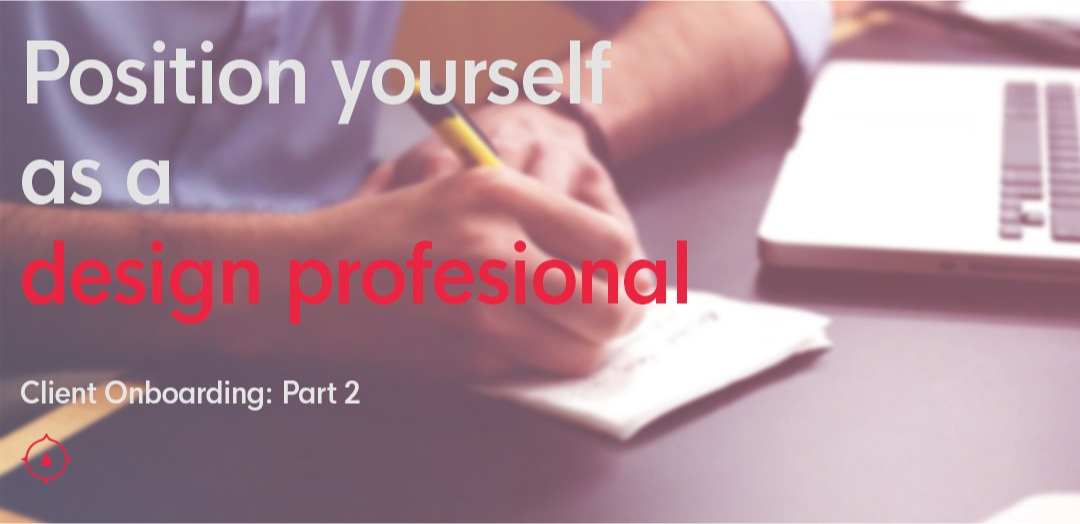When we talked last week, we said that a great designer can be measured by the quality of the questions they ask.
While this is true, being able to ask good questions is only a small part of the formula for becoming a great designer.
Another measure of a great designer is how well they can position themselves as a professional to the person hiring them.
Being a professional is much more than having a suit and a tie…
A professional is someone who holds themselves to a high standard *AND *can achieve those standards of their industry. A professional recognizes where the responsibilities lie and taking accountability for them with their actions.
You must make deliberate choices as a designer from your own evaluations or you’ll have those choices made for you.
As a designer, the first step to becoming a professional is to believe in yourself.
If you carry yourself as a professional, your clients will start to see you as a professional. It starts with belief in yourself.
If you aren’t able to start believing in the work you are doing, you’re going to have a difficult time moving past an amateur level.

For anyone who has had to interact with clients, the ability to be a good facilitator will be crucial to have the client see you as the professional.
It starts with the first impression.
Taking on new clients should be a focus for any freelancer or agency. The amount of effort you put into your onboarding experience will determine how the prospective client will measure your level of expertise.
A first impression can make or break the first interaction that someone has with you and your brand.
From the moment they enter your site, see you in person, or hear about you from others, you are on the clock to make a good first impression. The more premium the experience, the smoother the transition you’ll have going from their first interaction to winning their business as a client.
A few things influence the first impression: your portfolio, your case studies, your mission statement, your elevator pitch, and the questionnaire or process you start someone out with. Somewhere in the list, your next client will be introduced to you, your services, and your brand. But here’s the thing…
Your client doesn’t want to hear how great you are. They are looking to you because they want to know how you can solve their problems.
How effectively you can communicate what you can do for clients will determine how comfortable someone will be in hiring you.
Usually, the person who can define the problem or opportunity with the most clarity will get the job.
How you define the opportunity that the client has determines the way you will solve it.
Your website should be presenting professional level work.
We had talked about ways to make a portfolio that converts in order to start getting more or better quality work.
Now we just need to start leveling up that work and making sure that every bit of your design or case study is focused and presented in the best way possible.
You need to be using professional mockups to showcase your work. That work would best be accompanied by a case study to show your process.
Your portfolio is an acquisition channel to be used to gain new clients, make sure you put the effort in upfront and keep it updated with your best work.

They say that the customer is always right.
This may be true in many cases, and it will be true with the people you are designing for, but with all the status they get with working with you, it’s not their fault if something falls through the cracks.
If you want to position yourself as a professional, you have to be comfortable with taking responsibility for the whole experience.
It takes very little to see someone as an equal.
If you treat everyone as customers, you’re labeling them as another transaction instead of a person who you’re invested in working with. Though the client may be coming to you with their self-addressed solution, it would be a disservice to not ask more questions to get to know them and the project they are working on.
Rather than serving a customer what they want, you are serving your client by focusing and discovering what’s best for them in through your process.
Work on setting the roles and responsibilities as early as you can.
You need to be on the same page with your client on who’s responsible for parts of the process. A designer then can determine the means of communication, times of availability, methods of payment, etc.
Don’t leave any stone unturned or you might find yourself surprised when the client tries to take control of a part of your process.
Clients are going to assume responsibility for anything that you haven’t purely defined
It’s your job to set expectations
Most of the time, your client doesn’t do this with the intent to be rude. They want to help. But if you don’t set how the process should go, your client will be left to make that part of the process their own. How you communicate has a direct influence on how professional you come across, especially if you work with international clients.
I get asked sometimes how to get work with clients in a different country. To be able to work internationally you have to be really good at communicating with them in their language. You have to treat your interaction with a level of professionalism that you can “wow” the person hiring you.
Even if you don’t focus on international clients, you need to be able to communicate with them as professionally as possible. Impress them with your professional service.

Don’t make the client do your job
You are being hired because there’s a level of work that you do that this person either doesn’t know how to do, or doesn’t have the time to do.
A good client is someone who values their time, otherwise they would be trying to do the very thing you were being hired to do without you.
Some people struggle with this because they haven’t discovered exactly what they are best equipped to take care of. It would be wise to work on understanding how the work you do affects the company, brand, or industry you will be working in. This can be with reading on what the people you design for (both the client’s business and their customers) deal with on a daily basis.
This will provide context to your work, and as you grow your skills over time, spend time trying to understand the metrics to which your design will be measured.
You are a professional, you just have to act like it
Because you’re being hired for your expertise, you’re bringing a level of professionalism with you. However, if you are having to run to the client with every decision along the way, you undermine the value of your work, and it also devalues the client’s time.
If you need opinions on the work you’re doing, it helps to have people you trust that you are able to ask. I’m not saying that you never ask the client anything, either, but your process should have enough practice to get these questions upfront when you go through project discovery.
Rather than just designing nice visuals, your work is focused on attaining a goal that is important to the client. You need to have the client’s best interest in mind.
So by just making something pretty, you are subjectively projecting what you prefer instead of designing based on the client’s needs.
You can discover these needs with your questionnaires, your discovery process, or just by simply asking what they plan on focusing on in the future of their business.
Spend time this week looking at the way you present yourself as a designer.
Areas to look at are:
Your case studies: can your client see themselves going through the same process and getting the same results as your previous clients?
The actual display of your work: Are you using professional mockups or real-life applications of your design?
Your communication: Are you always patient and professional in the ways that you communicate?
With responsibilities: Are you making the design process for the client as friction-less as possible?
You are in charge of the impressions you make as a designer.
Make sure that impression is a good one (:

Want to level up your design skills?
Come join us in the Compass of Design Community to connect with other driven and motivated designers who are working at being masters of their craft.
We’re running a special deal for the whole month, so after September 31st our current promotion for membership will disappear.
Every week we go over ways to market yourself better by improving your design skills, your personal brand, and other topics to further develop as a great designer. Get around other like-minded and creative individuals to help get yourself in the next step of your design career.
Check out the Compass of Design to get started in investing in your skills as a designer (:
